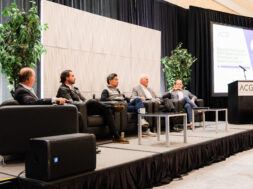Midmarket Suppliers Brace for Impact Amid United Auto Workers Strike
Ongoing UAW walkouts deal a blow to auto suppliers, dealerships and M&A dealmakers

The United Auto Workers union expanded the scope of its strike last Friday to additional automotive plants across the U.S., a move that puts the fate of many midmarket suppliers in limbo.
Workers walked out of all 38 parts-distribution centers operated by General Motors and Jeep-maker Stellantis in 20 states across the country as part of the expanded strike. (Facilities of Ford, the third member of the Big Three Detroit automakers targeted by the UAW strike, were excluded from the newly announced locations, due to progress in negotiations.)
The strike began on Sept. 15 at three of the 25 assembly plants operated by the Big Three. While much of the attention has focused on the impact to the original equipment manufacturers (OEMs), thousands of automotive suppliers could also feel the brunt of a UAW strike that’s expected to last at least several months.
Thanks to a backlog of inventory, most of the Big Three OEMs’ dealerships are still open and selling vehicles, which minimized the impact they felt during the first week of the strike. (The newly authorized strikes at parts and distribution centers, however, could quickly stymie dealerships’ repair activities, the most profitable part of their business, according to reporting from CNN.)
The dealerships are selling, they’re open for business, but it’s the suppliers that really get pinched.
Ted Morgan
Plante Moran
Suppliers, on the other hand, may be less fortunate. “The dealerships are selling, they’re open for business, but it’s the suppliers that really get pinched because their production orders for vehicles impacted by the strike will drop, quickly leaving them with an immediate labor challenge and a looming liquidity challenge,” says Ted Morgan, management consulting partner at accounting and advisory firm Plante Moran and a member of the firm’s Private Equity and Automotive/Mobility Industry leadership teams.
At this stage, many automotive suppliers have accounts receivable due for parts that were shipped in prior weeks. Morgan estimates a liquidity crunch to be up to a month away.
The strikes follow several years of auto suppliers contending with shortages and rising prices across semiconductors, steel, labor and freight. “They are still suffering from that, and then this is on top of it,” says Mark Barrott, leader of Plante Moran’s Strategy Consulting Practice and Automotive/Mobility Industry Practice.
Amid the challenges of the past several years, “the industry has been surprisingly resilient as earnings have increased throughout the industry,” he continues. “But if this strike goes to the extent of time that we think it might go—three months, four months, into 2024 potentially—if you are a supplier and you’re not seeing revenue for three months or a quarter, that’s going to have a big impact for you.”
A Long Road Ahead
Barrott and Morgan, along with many industry-watchers, expect a lengthy strike due to a mismatch between the UAW’s demands and concessions the Big Three are willing to make.
Among the sticking points is the union’s initial request for a 40% increase in wages over four years. The demands follow recent compensation gains achieved by unions in other industries, including a 48% average wage increase over five years for UPS workers secured by the Teamsters union in July.
The UAW strike, however, takes place within a competitive automotive industry in the U.S., where foreign-headquartered manufacturers like Toyota, Nissan and Honda, along with electric vehicle makers, operate primarily using non-union labor. Their average wage is significantly lower than at their unionized counterparts. Tesla, for example, pays workers $45 to $50 per hour, compared with $64 to $67 paid by the unionized OEMs, according to Axios.
Related content: State of the Union
As GM, Ford and Stellantis see it, paying a premium for the same type of work already puts them at a competitive disadvantage. The latest offer to the UAW from the Big Three proposes wage hikes of approximately 20% over the next five years. It’s an offer the automakers view as “very generous,” Morgan notes, even as the UAW continues to pursue wage increases closer to 40% over the next five years. “And that is why most in the industry, including us, think that this has a lot of the makings of being a prolonged strike,” Morgan says.
Another specter looming over the strike is the automotive industry’s shift toward electrification. “Underlying this is the transition of the industry,” says Barrott. “The UAW sees an industry that is fundamentally going to need less labor, is moving geographically from their stronghold in the Rust Belt and is simplifying at a rate which is significant.”
The large automakers have achieved record-level profits in recent years. The Big Three automakers’ profits collectively amounted to $21 billion in the first half of 2023, according to reporting from NPR. Yet their vision for deploying that capital differs greatly from the union’s. “They don’t want to spend their liquidity on propping up a strike,” Barrott says. “They want to spend their liquidity on new capital investments in plants and machinery, to take them into this electric future. Both sides are prepared for a long-term struggle.”
Staying Afloat
As an automotive supplier caught in the crosshairs, there’s unfortunately no silver bullet to shield one’s business from the impact of the strikes, Morgan says. Focusing on smart liquidity management is likely the best option.
It’s also a good time to be strategic with contract negotiations, particularly for manufacturers that supply automakers unaffected by the strike and customers outside of the automotive sector. “If you’re about to negotiate a new contract with a customer that’s unaffected by the strike, and they’re asking you to sharpen your pencils to get your bid a little tighter—you may want to sharpen that pencil a little more, given the uncertainty being caused by the strike,” Morgan says.
The UAW walkouts will also affect mergers and acquisitions. An in-progress deal involving a supplier to one of the Big Three automakers will likely see the seller’s valuation decline and potentially cause a delay or withdrawal from deal talks until the strike is resolved.
In the meantime, suppliers should tread carefully as they wait out the storm. “Think about investment decisions, pricing decisions, how you treat your customers that aren’t affected by the strike. You want to be strategic here,” Morgan says. “Over the next two, three, four months, it’s going to be a very fluid situation.”
Katie Maloney is ACG’s content director, based in Chicago.
Middle Market Growth is produced by the Association for Corporate Growth. To learn more about the organization and how to become a member, visit www.acg.org.


